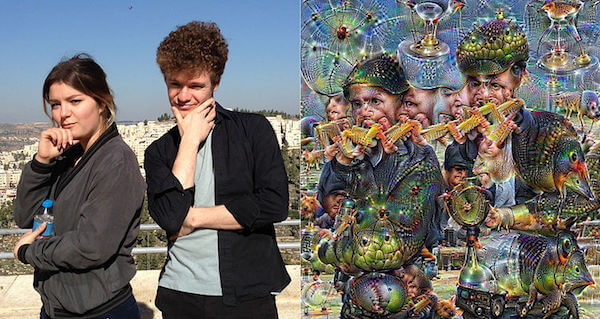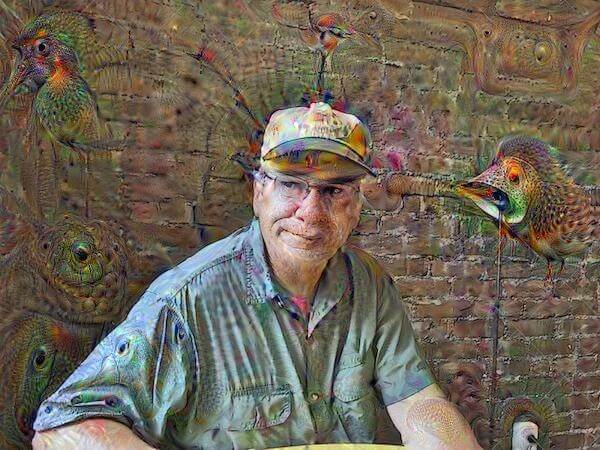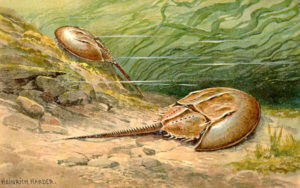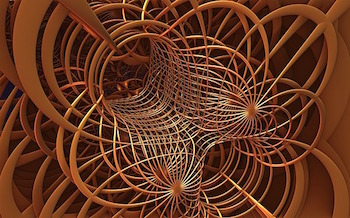Playing with Pareidolia
Or: Why Is That Cloud Eating Grass?
Everyone plays the game as kids—the one where you look for objects in clouds, right? Even the least-imaginative kids could at least see sheep. Well, it turns out there's a name for it, and it's actually pretty important.

It's called pareidolia. Broadly speaking, this is the brain's ability to perceive a familiar pattern in a stimulus where none actually exists. Other examples: mountainsides that resemble faces and trees that look like people.
People aren't the only entities that experience pareidolia. Computers do it, too. Google has a program called DeepDream that specifically sets out to exploit this, and it produces some really, really weird results. (DeepDream especially sees a lot of dogs.)
Pareidolia is fairly important in science, and it causes a lot of problems in archeology and paleontology. Amateurs are constantly picking up rocks they mistakenly think are arrowheads, dinosaur eggs, or bones. This happens so much that there's a specific name for rocks like this: mimetoliths. This also includes larger rocks, like the mountainsides that look like faces.

Yeah, well.
The most famous applied use of pareidolia is the Rorschach inkblot test, which is supposed to give insight into a person's mental state. A fairly successful tool, we’ve used the Rorschach continually since the early 20th century—fairly astonishing, since psychology has thrown away so much from that time period.
If you're familiar with the tabloid-fodder “Jesus appears on toast” articles, you've stumbled on another example of pareidolia.
It also sees extensive use in art, which is unsurprising. Many optical illusions (like the famous one that could either be a lamp or two faces) are good examples. Leonardo da Vinci wrote about pareidolia as a tool in art. Pareidolia is one of the main reasons cartoons work so well, making it easy for us to assign complex emotions to simple line drawings of people.
Pareidolia isn't good or bad—just reflects an aspect of how our brains interpret the world—but can also lead you astray. This phenomenon is also probably one of the coolest oddities involved in discovering how our brains work.
_________
Quotable
Oh, Yard Ramp Guy: are we seeing the same things differently?
“There are things known and there are things unknown, and in between are the doors of perception.”
— Aldoux Huxley
Beta Testing WolframAlpha
Searching for the Optimal Search Engine
Q: What is the average weight of a panda?
A: 170-290 lbs.
 There are a lot of different search engines out there, but most people never feel the need to go past Google. For the most part, I'm with them. I have discovered a few specialty search engines that I visit on a regular basis. Most of these are simply engines that search inside a specific website, usually Wikipedia. There are a couple exceptions, though. The biggest one is called WolframAlpha.
There are a lot of different search engines out there, but most people never feel the need to go past Google. For the most part, I'm with them. I have discovered a few specialty search engines that I visit on a regular basis. Most of these are simply engines that search inside a specific website, usually Wikipedia. There are a couple exceptions, though. The biggest one is called WolframAlpha.
Q: How many people have the given name McCoy?
A: 1649 estimated to still be alive in the United States.
Strictly speaking, WolframAlpha isn't a search engine at all. It's a computational knowledge engine. Its creator, Stephen Wolfram, designed the engine to answer factual questions by using its curated internal database of information. This is a very different function than search engines, which provide a list of documents or web pages that might contain the answer.
Q: Motorcycle traffic in Germany?
A: 11.1 billion vehicle miles per year.
WolframAlpha can perform arithmetic, trigonometry, algebra, and numerous other mathematical functions. It contains population estimates from around the globe. It records weather data from the past in the database. And so this computational knowledge engine can use all of this information, along with its countless volumes of other information, to calculate the answers to a huge number of questions.
Q: Melting point of teflon?
A: 327 degrees Celsius. (620.6 degrees Fahrenheit)
Not to say that Wolfram Alpha is perfect. Its databases don't contain anywhere close to even a significant percentage of human knowledge. It doesn't know the average speed of a turtle, for instance, so you couldn't use it to figure out how long it would take one to cross the United States.

My own computational knowledge engine.
A fun Twitter account I ran into the other day is dedicated entirely to sharing odd questions that Wolfram Alpha can't answer. My personal favorites:
- “Hectares of cotton crops needed to make a superhero cape for every land mammal.”
- “Total work done against gravity to make a cupcake rise while baking it, in calories?”
- “Most common English misspelling that changes the word's Scrabble score by more than 4?”
And knowledge crawls onward…
Q: Anchorage, Alaska weather on 7/7/07?
A: Overcast, 54 to 61 degrees Fahrenheit, wind 0 to 7 mph.
Q: Most frequently erupting volcano?
A: Stromboli, in Italy.
Q: 20 gallons of gloss paint?
A: 14,000 square feet, assuming it has a spreading capacity of 690 square feet per gallon.
Q: How long did the Paleoproterozoic Era last?
A: 900 million years.
Q: x+y=10, x-y=4
A: x=7, y=3
Q: What's the temperature of the solar wind?
A: 31,000 Kelvin.
_________
Quotable
So, Yard Ramp Guy: what do you know today?
“The true sign of intelligence is not knowledge but imagination.”
— Albert Einstein
Health Through Horseshoe Crabs
The Value of Blue Blood

Nobility don't literally have blue blood, but horseshoe crabs do, and it's worth quite a bit of money—up to $15,000 per quart.
Horseshoe crabs are ancient critters. We actually consider them living fossils, in that they appear in the fossil record some 450 million years ago.
Though they're called crabs and look like crustaceans, they actually aren't; they're more closely related to spiders. Some species grow to around two feet long. They crawl around on shallow ocean bottoms in sandy and muddy areas, looking for worms and mollusks to eat. They've also been known to eat crustaceans and small fish.
Their blood is a deep, rich blue color due to the presence of hemocyanin—a chemical similar to hemoglobin that carries oxygen through the blood but uses copper instead of iron (which is what makes our blood red). Hemocyanin is somewhat more effective at carrying oxygen in cold, oxygen poor environments than hemoglobin, though hemoglobin is more effective overall.
What really makes the blue blood of horseshoe crabs valuable is how it reacts to disease.

I'm feeling a bit crabby myself.
Certain cells—called amoebocytes—in the horseshoe crab's immune system are extremely sensitive to bacteria and react by clotting around the infection in an inescapable lump. Pharmaceutical companies burst the cells to harvest coagulogen, the chemical that lets the cells do their thing.
The coagulogen can then be used to detect bacterial contamination in any substance that might come into contact with blood, even at levels as low as one part per trillion. This test has become the absolute standard: every single drug used in the country is required to be tested this way.
This isn't necessarily good for the crabs, though, and the species has also spent quite a bit of time being used as fertilizer and as bait. Over time, this has damaged the population quite a bit.
Though most of the crabs survive the bleeding process, some 15% die and others are rendered too lethargic to mate. All of which is pretty problematic, since they're harvested during mating season.
Scientists are working on an artificial replacement for coagulogen, but that might not help the crabs too much. When science perfects the artificial coagulogen, we’re likely to use our horseshoe crabs as bait.
The Rodney Dangerfield of anthropoids, they just don’t get any respect.
_________
Quotable
Oh, Yard Ramp Guy, replace “cranky” with “crabby,” and I still claim a blog-specific quotation here:
“I'm cranky.”
— Larry David
Scanning for Radiation
Or: Careful with that Shipwreck

What do Geiger counters, medical scanners, aeronautical sensors, space sensors, and photon detectors have in common?
If you said that they're all sensors of one sort or another, you're obviously correct. If you said that they're all sensors for detecting radiation, you're even more correct.
In fact, you can list many different traits that they all have in common. They all fit pretty easily into a few categories.
The reason I asked, though, is due to one very specific and shared quirk: they're all largely built out of salvaged shipwrecks.
Each of these devices requires high levels of sensitivity, meaning that they can't be radioactively contaminated themselves—not even a little bit.
Unfortunately, the overwhelming majority of steel we’ve produced worldwide since the Trinity nuclear bomb test (in 1945; the first time humans detonated a nuclear weapon) is contaminated with higher-than-normal levels of radionuclides (radioactive particles) such as Cobalt-60.

This has been McCoy Fields, man of steel.
This occurs because both the Bessemer process, converting molten pig iron into steel, and the modern BOS steel-making process involve atmospheric gas, with little bits of radioactive particulate drawn in from the atmosphere and planted in the steel.
Though the amount of radioactive materials in the air has dropped drastically since 1963, when nations enacted the Partial Nuclear Test Ban Treaty, radiation still lingers in steel. And we keep recycling our old radioactive steel as scrap metal.
Because of all this, devices that require low levels of radioactive contamination—like our sensors and scanners—can’t use modern steel. Which means that we must use steel produced before the Trinity test.
The best sources of this? Sunken ships—most notably, the scuttled German WWI battleships at Scapa Flow in Scotland.
_________
Quotable
Oh, Yard Ramp Guy, I might just sink your battleship with this one:
“A person without a sense of humor is like a wagon without springs. It’s jolted by every pebble on the road.”
— Henry Ward Beecher





